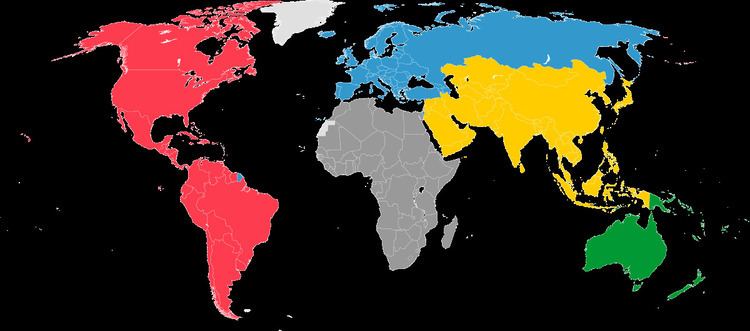Sport Basketball Continent Europe | Founded 1992 | |
 | ||
Country FIBA Europe member associations TV partner(s) 52 official broadcasters Official website ULEB.com
EuroLeague.net
EuroCupBasketball.com
FIBAEurope.com
BasketballChampionsLeague.com
FIBA Europe Cup | ||
The European national basketball league rankings are the rankings for each of the different European regional and domestic basketball leagues that are eligible to participate in Europe's international continental-wide professional club basketball competitions, such as the EuroLeague and the EuroCup. FIBA Europe's two continental-wide competitions, the Champions League and the FIBA Europe Cup, also fall under the rankings system. The rankings are decided on by Euroleague Basketball, which runs the EuroLeague and EuroCup competitions.
Contents
- Euroleague Basketballs ratings system criteria
- Arena standards and qualifications
- Club ranking
- Minimum points ranking
- Coefficient country ranking criteria
- References
Clubs from the different European national domestic and regional leagues are eligible to compete in Europe's four continental-wide professional basketball competitions. Which include, the first-tier level EuroLeague competition, EuroLeague Basketball's second-tier level EuroCup competition, FIBA Europe's self-anointed 2nd-tier level (which is disputed by Euroleague Basketball, which considers it as the 3rd-tier level) Champions League competition, and the fourth-tier level competition, which is called the FIBA Europe Cup. The Champions League and FIBA Europe Cup competitions are run by FIBA Europe, but with the understanding of Euroleague Basketball and the clubs themselves, those leagues also fall under the European national domestic and regional league rankings system.
Generally, top ranked domestic and regional clubs compete in the EuroLeague, while higher-end mid-level domestic and regional clubs compete in the EuroCup and Champions League, which also contains mid-level clubs from the best national leagues, and high-level clubs from smaller national leagues.
Euroleague Basketball's ratings system criteria
Television revenues and ratings, arena attendance figures, and arena seating capacities, are also used to determine the rankings of national domestic and regional leagues by Euroleague Basketball. The ratio distribution is based on 70 percent basketball game competition results, and 30 percent TV revenues/ratings, attendance figures, and arena capacities. It is important to note that because of this, Euroleague Basketball's national league rankings are not based merely on the basketball strength of each respective domestic or regional league.
FIBA Europe uses game competition results from national domestic leagues, when choosing which clubs get to take part in their Champions League competition. Nonetheless, they use the same method of counting points for ranking national domestic and regional leagues, from wins and losses in European-wide leagues, as Euroleague Basketball does.
Euroleague Basketball's national domestic and regional league rankings were originally to be updated once every three years, starting in 2009, and to take into account the results from the previous three seasons. So, the rankings were not originally based on a per season, or current season basis.
In 2012, Euroleague Basketball decided to update the rankings every year, and take into account the results from the previous seasons. The rankings, as of 2007, are also based on 70 percent basketball game competition results, and 30 percent TV revenues/ratings, attendance figures, and arena capacities.
Arena standards and qualifications
There are also arena rules for inclusion in the continental club competitions. Starting with the 2012–13 season, to compete in the first-tier EuroLeague competition as a contract club, clubs must play in arenas that seat at least 10,000 people. Non-contract EuroLeague clubs must play in arenas that seat at least 5,000 people. Second-tier EuroCup clubs must play in arenas that seat at least 3,000 people.
Also, clubs must be in good standing with FIBA Europe's club rules and regulations. This means that clubs that have been punished in court for unpaid financial obligations to players, coaches, or agents, and have refused to meet them, cannot compete in any of the four continental competitions. Also, starting with the 2015–16 season, teams that compete in the first-tier EuroLeague competition are required to meet a minimum budget rule.
Club ranking
The Club ranking is determined by the results of professional basketball clubs in the EuroLeague and the EuroCup, over the previous three seasons, excluding the competition's qualifying rounds.
Minimum points ranking
The minimum points ranking is calculated by adding the results of the worst performing team from each league. These points indicate the lowest possible position that any club from that country or league can occupy in the draw of the EuroLeague and the EuroCup.
These are the final standings after the 2015–16 season (current rankings).
Coefficient country ranking criteria
This is an unofficial European national domestic and regional league ranking from the Gigabasket.org website. These rankings are calculated by a weighted points system, on a per season basis, and are based on results from how teams from different national domestic and regional leagues perform in European-wide competitions. This weighted rankings system is a similar system to UEFA's coefficient system, that is used to rank European football leagues.
It should be noted that these are not the official Euroleague Basketball national domestic and regional league rankings, as Euroleague Basketball no longer releases the official national domestic and regional league rankings to the public. These are only the rankings of Gigabasket.org:
Through the 2015–16 season (current rankings).
